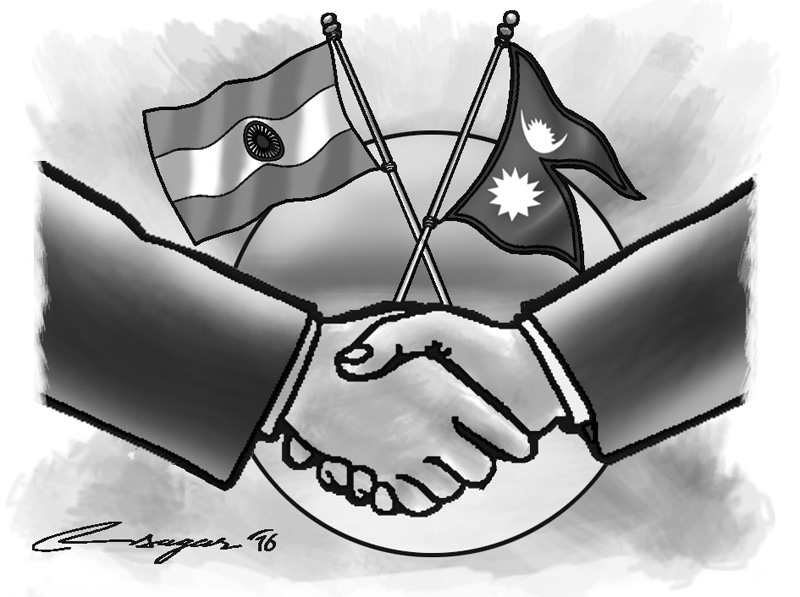Constitutional conundrum: A hard nut to crack
The present politics has its genesis in the signing of the twelve-point agreement between the Maoists and the political parties in India that ultimately overthrew the monarchy
The issue of amending the constitution is getting knottier day by day with the sharp opposition of the CPN-UML against it.
The more pressure put on PM Prachanda by the agitating outfits forcing him to mend his fences with the UML, the harsher UML is getting towards amending the constitution.
Perhaps, PM Prachanda forgets the humiliation the UML had suffered by him when it was ousted from power unceremoniously.
The dream of then PM Oli to rule the country till January, 2018 after showing the then PM Sushil Koirala the door by getting the constitution proclaimed was shattered.
Ironically, for passing the crucial amendment bill, the government does not have a two-thirds majority, and it has to depend on the CPN-UML which is opposing it by considering the Madhes-based parties’ demands divisive and sees India behind it.
Apparently, the visit of Indian president Pranab Mukherjee in early November was to improve Nepal-India relations; it really coincided with a time when Nepal was seriously engaged in tackling its most complex issues of amending its constitution which some Madhesi, Tharu and Janajati outfits are demanding.
It was a visit by the titular head of the state and not by the head of the government that formulates its policies.
During his visit the Indian president not only met his counterpart, the PM and senior leaders of the Nepali Congress, but was also particular in meeting the senior leaders of the CPN-UML who see an Indian hand behind the UML’s ouster from power.
He also met some prominent Madhesi parties’ leaders. He got opportunities to express India’s interest in a peaceful, stable and prosperous Nepal in a seminar in harnessing water resources jointly and called upon Nepal to share the Indian ’growth story’ at the convocation ceremony organized to confer the Honorary D.Litt. degree on him.
It is commonly believed that for improving the relations instead of arranging visit by the Indian president, the cancelled visit of Nepalese President Bidya Devi Bhandari to India could have been rearranged.
Her visit was cancelled by the then Oli-led government when Nepal-India relations were very strained.
Unlike president K Narayanan and president N. Sanjiva Reddy’s visits his visit looked persuasive as he was the most appropriate personality having long associations with the Nepalese leaders, and was chosen by New Delhi to untie the Gordian knot of present diplomatic confusion amid the apparently growing Chinese financial investment in Nepal.
At this juncture, when the two sides were at odds with each other it was presumed that sound presidential counsel might be effective.
President Mukherjee was the second president after Reddy to visit Janakpur, a religious place and the central nerve of Madhes politics as well. Curiously, no Indian Prime Minster has visited the place and the planned visit by PM Narendra Modi was cancelled at the eleventh hour.
Perhaps, there seem to be some psychological reasons behind restricting the visits of Indian leaders to Madhes. It was guessed that in order to facilitate his visit to Janakpur, his visit to Pokhra was included in his itinerary.
Truly, the golden days of friendly Nepal-India relations had ended with the demise of King Tribhuvan, as the late king and Pt Nehru used to address each other as friends in their correspondence.
King Mahendra became an assertive king and tried to balance between India and China, but tried occasionally to please India to keep democracy away.
King Birendra’s proposal for declaring Nepal a ‘ zone of peace’ was really an effort to neutralize outside influence on Nepalese politics and keep Nepal safe from the harmful effects of foreign interference.
However, he was forced to restore democracy through the people’s movement supported by India. The present politics has its genesis in the signing of the twelve-point agreement between the Maoists and the political parties in India that ultimately overthrew the monarchy.
At the time of drafting the constitution by the elected Constituent Assembly, India’s advice to make the constitution ‘inclusive’ was not heeded by the parties in power leading to the Madhes uprising.
Connected with it, Nepal also experienced the blockade imposed on imports from India and from third countries via Indian land routes. That added complexity to Nepal-India relations.
The recent political postures of certain Madhesi and Janajati organizations have made Nepal-India relations more complex. Therefore, India is in a dilemma to maintain its effective position.
It cannot please both the hill origin people (including Kathmandu elite) and the agitating parties. If it sides with the hill people it will be displeasing the Madhesi parties and if it takes up the latter’s causes seriously, the complex relations will continue.
Unfortunately, it faces another dilemma with regard to China’s role in Nepal. It cannot equal China in providing economic assistance to Nepal.
And on the other hand, its interest in sharing water resources with Nepal limits its negotiating capacity. Apparently, the Indian suggestion for making the constitution ‘inclusive’ did not go down well in many quarters in Nepal.
However, the presidential visit is a step forward in normalizing Nepal-India relations, but India needs more to do to see that its bilateral relations with Nepal are enhanced.






